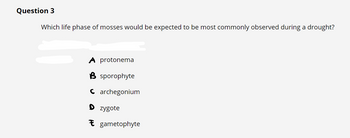
Human Anatomy & Physiology (11th Edition)
11th Edition
ISBN: 9780134580999
Author: Elaine N. Marieb, Katja N. Hoehn
Publisher: PEARSON
expand_more
expand_more
format_list_bulleted
Concept explainers
Question

Transcribed Image Text:Question 3
Which life phase of mosses would be expected to be most commonly observed during a drought?
A protonema
B sporophyte
Carchegonium
D zygote
gametophyte
Expert Solution
arrow_forward
Step 1
Introduction
Mosses are a taxonomic group of tiny, non-vascular, flowerless plants. The parent group bryophytes, which includes hornworts, mosses, and liverworts, is also referred to as bryophyta. In wet or shaded areas, mosses frequently develop dense, green mats or clumps. The basic leaves on individual plants are typically only one cell thick, linked to a stem that may or may not have branches, and play a very limited role in transporting water and nutrients.
Step by stepSolved in 2 steps

Knowledge Booster
Learn more about
Need a deep-dive on the concept behind this application? Look no further. Learn more about this topic, biology and related others by exploring similar questions and additional content below.Similar questions
- Plants developing in dry conditions are: A. xerophytes B. mesophytes C. lithophytes D. hydrophytesarrow_forwardWhich of the following make up the vascular tissue found in a moss? can select more than one answer Group of answer choices Stomata Phloem Mosses don't have vascular tissues Xylemarrow_forwardWhat's the difference between gametophyte and sporophyte?arrow_forward
- Which term is not present in bryophytes? chloroplasts rhizoid cells phloem cells a sporangiumarrow_forward11. Is this structure from the moss life cycle part of the sporophyte or gametophyte generation?arrow_forwardOne reason that mosses are dependent on wet environments is; They lack a cuticle They do not have rhizoids They need water for fertilization They produce seedsarrow_forward
- Label the parts of the heterosporous vascular plant life cycle. A, B, C, D, E, F, G, H, I, J, K, L, and M.arrow_forwardQUESTION 2 Which of the following is true of the moss life cycle? The male and female structures are found on the same individual gametophyte in many species The egg is produced in the antheridium. The gametophyte is dependent on the sporophyte. The sperm are carried to an egg by the wind. The spore produces the sporophyte.arrow_forwardThe reconstruction of Asteroxylon in Figure 21-10 shows thin, leaf-like flaps of tissue on the plant’s surface. What are these called? Did they ever have stomata in any of the zosterophyllophytes? Did they have vascular bundles? Did they ever become large (Hint: Look at Figure 21-13)?arrow_forward
- Why even shrubs cant grow beyond the “shrubline” in the far north? What type of cell is found in the wood of Anthophyta, but not in the wood of Coniferophyta what are the Tube-like cells for conducting water and minerals in Anthophytaarrow_forwardFerns are; Sporophyte dominant Gametophyte dominant O Neitherarrow_forwardWhat does it mean to say that mosses and other nonvascular plants have life cycles dominated by gametophytes? asap pleasearrow_forward
arrow_back_ios
SEE MORE QUESTIONS
arrow_forward_ios
Recommended textbooks for you
 Human Anatomy & Physiology (11th Edition)BiologyISBN:9780134580999Author:Elaine N. Marieb, Katja N. HoehnPublisher:PEARSON
Human Anatomy & Physiology (11th Edition)BiologyISBN:9780134580999Author:Elaine N. Marieb, Katja N. HoehnPublisher:PEARSON Biology 2eBiologyISBN:9781947172517Author:Matthew Douglas, Jung Choi, Mary Ann ClarkPublisher:OpenStax
Biology 2eBiologyISBN:9781947172517Author:Matthew Douglas, Jung Choi, Mary Ann ClarkPublisher:OpenStax Anatomy & PhysiologyBiologyISBN:9781259398629Author:McKinley, Michael P., O'loughlin, Valerie Dean, Bidle, Theresa StouterPublisher:Mcgraw Hill Education,
Anatomy & PhysiologyBiologyISBN:9781259398629Author:McKinley, Michael P., O'loughlin, Valerie Dean, Bidle, Theresa StouterPublisher:Mcgraw Hill Education, Molecular Biology of the Cell (Sixth Edition)BiologyISBN:9780815344322Author:Bruce Alberts, Alexander D. Johnson, Julian Lewis, David Morgan, Martin Raff, Keith Roberts, Peter WalterPublisher:W. W. Norton & Company
Molecular Biology of the Cell (Sixth Edition)BiologyISBN:9780815344322Author:Bruce Alberts, Alexander D. Johnson, Julian Lewis, David Morgan, Martin Raff, Keith Roberts, Peter WalterPublisher:W. W. Norton & Company Laboratory Manual For Human Anatomy & PhysiologyBiologyISBN:9781260159363Author:Martin, Terry R., Prentice-craver, CynthiaPublisher:McGraw-Hill Publishing Co.
Laboratory Manual For Human Anatomy & PhysiologyBiologyISBN:9781260159363Author:Martin, Terry R., Prentice-craver, CynthiaPublisher:McGraw-Hill Publishing Co. Inquiry Into Life (16th Edition)BiologyISBN:9781260231700Author:Sylvia S. Mader, Michael WindelspechtPublisher:McGraw Hill Education
Inquiry Into Life (16th Edition)BiologyISBN:9781260231700Author:Sylvia S. Mader, Michael WindelspechtPublisher:McGraw Hill Education

Human Anatomy & Physiology (11th Edition)
Biology
ISBN:9780134580999
Author:Elaine N. Marieb, Katja N. Hoehn
Publisher:PEARSON

Biology 2e
Biology
ISBN:9781947172517
Author:Matthew Douglas, Jung Choi, Mary Ann Clark
Publisher:OpenStax

Anatomy & Physiology
Biology
ISBN:9781259398629
Author:McKinley, Michael P., O'loughlin, Valerie Dean, Bidle, Theresa Stouter
Publisher:Mcgraw Hill Education,

Molecular Biology of the Cell (Sixth Edition)
Biology
ISBN:9780815344322
Author:Bruce Alberts, Alexander D. Johnson, Julian Lewis, David Morgan, Martin Raff, Keith Roberts, Peter Walter
Publisher:W. W. Norton & Company

Laboratory Manual For Human Anatomy & Physiology
Biology
ISBN:9781260159363
Author:Martin, Terry R., Prentice-craver, Cynthia
Publisher:McGraw-Hill Publishing Co.

Inquiry Into Life (16th Edition)
Biology
ISBN:9781260231700
Author:Sylvia S. Mader, Michael Windelspecht
Publisher:McGraw Hill Education